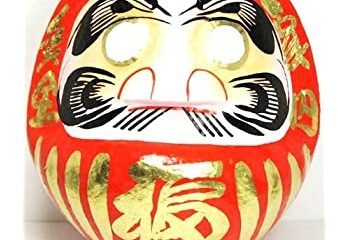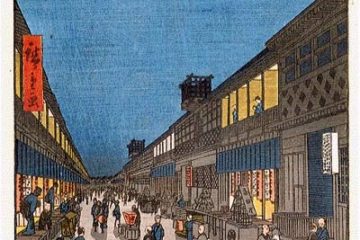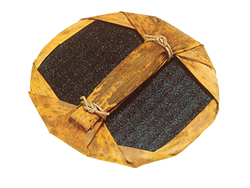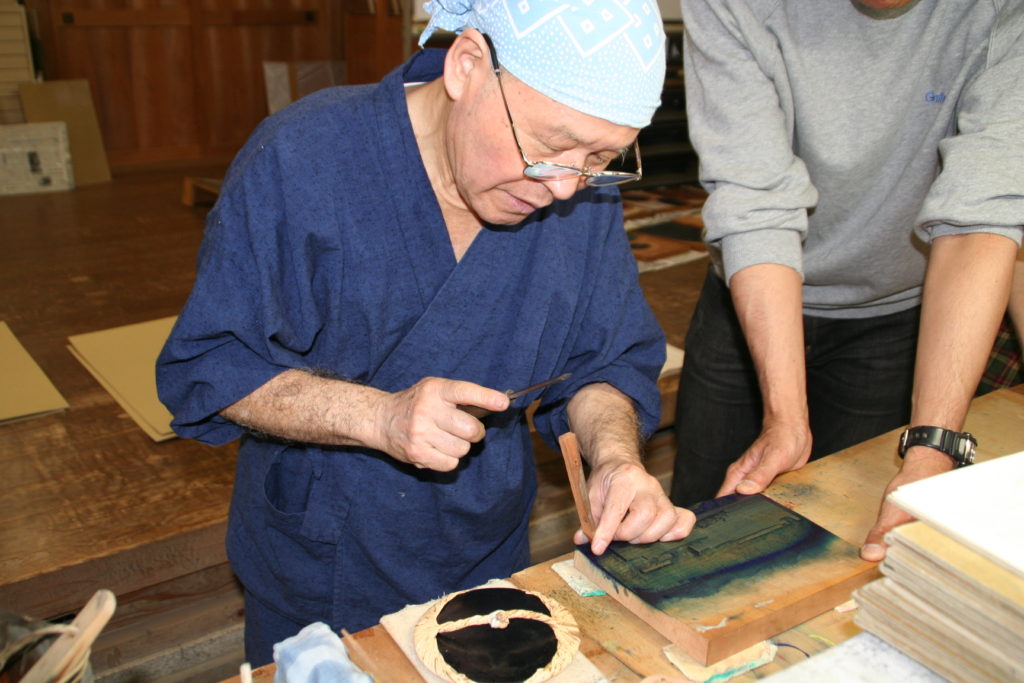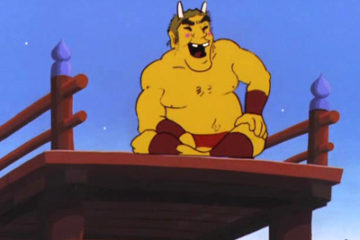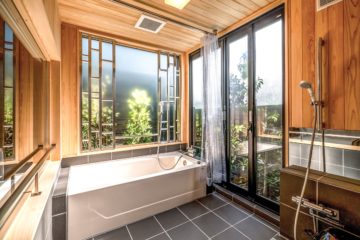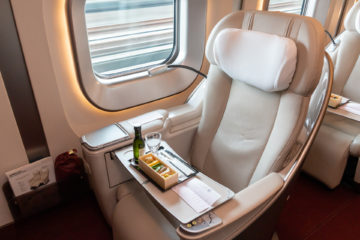A daruma is a papier-mâché doll which is painted red except for the face and weighted at the bottom. It represents the Buddhist priest Bodhidharma, who lived in sixth century China, sitting in a lotus position. The doll is considered to bring good luck, because it always comes back to an upright position after being tipped over. Some daruma have no eyes. People paint one eye in right away, wishing for something to come true; the other is supposed to be painted when the wish is realized. The origins of the red color of the daruma can be traced back to the red robe that was supposedly worn by Bodidharma. But it was also believed that the color red has the effect of keeping evil away. Incidentally, in recent years, as well as the traditional red models, daruma dolls colored yellow, white, green, gold, etc. can also be found for sale.
Blog News about Japan 未分類
What is “Kappa”? 河童(かっぱ)
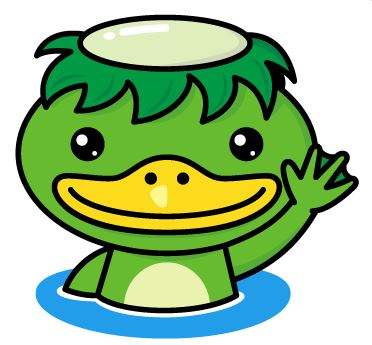
A kappa is an imaginary tortoise-like creature with a brimming dish of water on top of its head, a pointed muzzle, and webbed hands and feet. Kappa often appear in old stories and pictures. They are revered at water-god festivals in hope that they will offer protection against water mishaps. Kappa are said to be fond of cucumbers, so rolled cucumber sushi is called, “kappa maki.” Kappa are believed to be good swimmers, so if you say, “Jiro wa kappa desu,” which means Jiro swims like a fish. Also there is a famous saying, “Kappa no kawa nagare” meaning a kappa drowning in a river. “Even Homer sometimes nods” is a similar English saying.
Blog News about Japan 未分類
Hi-tech Capsule Hotel in Kyoto
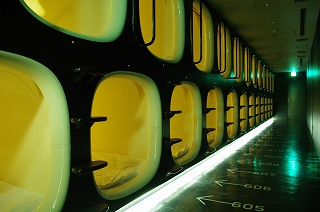
One night’s accommodation in a hotel in central Tokyo can easily cost between 10,000 to 20,000 yen. This might be affordable for a tourist, but for a person on a business trip who just needs a place to go after work to shower and sleep, 20,000 yen is far too expensive. This led to the creation of affordable “capsule hotels” in Japan. As they provided sleeping space for around 3,000 yen they were used mostly by salaried workers who were working overtime and missed their last train home, but initially had a reputation of being unsanitary, dangerous (because pilferage occurred), and inconvenient in terms of location. To address these problems, last year a new type of establishment named “9h” began operations, offering “a place to wash off the grime,” “restful sleep” and “prepare the body for the next day.” The aforementioned three activities generally require one hour, seven hours and one hour, respectively, for a total of nine hours — and hence the name “9h.” To make this possible, a famous designer was requested to make the sleeping capsules more attractive and stylish. Guests are assigned lockers that open with keys and sleepwear. The floors for female and male guests are segregated, as are the elevators to access the floors. To provide female guests with a greater sense of safety, a security camera is configured to detect if a male enters the women-only floor, and notifies the staff. This hotel is convenient located in a commercial and tourist area about five minutes’ walk from Kyoto’s Shijo station. The company that operates 9h is proceeding with plans to open new branches in Tokyo and Osaka. About 70% of guests are foreigners. The hotel has been inspected by many people in Japan and from overseas with an interest in architecture and design. The hotel was named recipient of the Japanese government’s Good Design Award in 2010.
Note: The Good Design Award is Japanese comprehensive design evaluation and commendation system, operated by Japan Industrial Design Promotion Organization (JIDPO). The system has its origins in the “Good Design Selection System” (known as the “G-Mark System”) instituted by the Ministry of International Trade and Industry of Japan in 1957.
Blog News about Japan 未分類
WHAT IS UKIYO-E?
Ukiyo-e is a kind of woodcut print which flourished from about the 1680s and 1850s in Japan. The word ukiyo-e means “pictures of floating world” as the themes usually depicted the beautiful, fleeting world of entertainers such as kabuki actors and geisha. Later, pictures of scenery would also become popular. Because the printmaking medium allowed for mass reproduction, ukiyo-e became a form of artwork that the rising merchant class could afford. Overseas, this stylized pop art garnered the attention of Impressionists such as Monet. Vincent van Gogh created his interpretations of two famous works by ukiyo-e master Utagawa Hiroshige. Because they often depicted urban life in the Edo period, ukiyo-e also became culturally important as historical testimonies.
An Amateur’s Initiation into Ukiyo-e Printmaking
If you are an admirer of ukiyo-e woodblock prints, you can attend a half-day workshop to make your own. Boso-no-Mura is a museum in Chiba Prefecture where visitors can learn about Japanese culture firsthand by making various traditional foods, arts and crafts themselves. If you are lucky, the receptionist might tell you there is a cancellation for the ukiyo-e printmaking workshop. An extremely popular course, it usually gets booked up months in advance.
The smell of fresh ink is slightly overwhelming when you first enter the printmaking workshop. Assistants ensure beginners master the basic concepts by experimenting on scrap paper. At this stage, it seemed fun and easy.
Ukiyo-e is made by a method where multiple blocks are used for separate portions of the image. On one block, only images designated a certain color would be carved onto the wood. The painting we would work on that day was a scene of the Sumida River and consists of seven color blocks. We are each given a piece of Japanese “washi” paper, which absorbs the ink beautifully, with the drawing etched in black lines. The most difficult and important aspect of suri printing is lining up the paper precisely so the color inks are pressed onto the designated places of the drawing. A specialized tool called the baren, a small, wooden iron, is used to burnish the colors onto the paper. Gradation is a high level skill that is created by applying various levels of pressure with the baren. The order of the plates used progresses from the lightest color to the darkest and from the areas with the least color to the most. The real ukiyo-e process is daunting.
A significant appeal of the workshop is spending time with Keizaburo Matsuzaki. Born in 1937, he has been making prints for almost 60 years. Between 1998 and 2004, Matsuzaki undertook a tremendous project in completing the 120-print collection of Utagawa Hiroshige’s “One Hundred Famous Views of Edo” for the Tokyo Edo Museum. In 2001, he received the distinction of being a Designated Traditional Artisan by the city of Tokyo. He is also recognized as a cultural treasure of Arakawa city, Tokyo and generally recognized as a living master of suri, Japanese woodblock printing.
It is a treat to watch Matsuzaki inspect each block diligently, chiseling away at edges that have softened with use. Even for a class of amateurs, for every new block used, he would make multiple trial copies until the amount of ink is optimal. To be an eye-witness to the passion, the commitment and the painstaking attention to detail of a master artisan is truly inspiring.
The term eddoko (Edo’s Child) is often bantered around to describe someone who is opinionated, stubborn and straight-talking. Because Japanese society is cloaked in vague polities, edokkos are frequently admired for their outspoken attitude. Matsuzaki is a true edokko.
“Bad, bad! That’s really horrid.” Matsuzaki does not mince words. “Did you not listen to a word I said? Watch now and this time, don’t forget. Remember to line up the corner, don’t rush and keep the paper straight,” he addressed me specifically as I carelessly rushed through the yellow woodblock. The color did not match the lines of the paper and I shuddered at the realization that in this craft, this is no second chance.
With some trepidation, I lined up the orange woodblock and pressed my paper with the baren. I unpeeled it to see that the orange colors fit within the lines perfectly. Matsuzaki inspected. “Ah, spectacular. I knew you weren’t stupid!” he said.
I felt accomplished and almost moved to tears. A woman doing her fifth workshop with Matsuzaki, smiled kindly at me, “Way to go,” she whispered. A completely unexpected development of attending this print workshop is the comradely formed between the seven participants. Mutual encouragement is needed to console each other through this artisan initiation and survive Matsuzaki’s barbed remarks.
The worse fear of ukiyo-e printmaking is getting the wrong color on an absolutely irrelevant place. When I confessed to the class, a man reassured me that since we were doing scenery, even the worst mistake would not be as bad as when he did a print of a geisha – and clearly misplaced the lips. “With two sets of lips, she looked like an alien,” he says. Yet this man persists on coming. “I’m still not good but I am getting better and there’s satisfaction in that,” he says. Indeed, the appeal of being an artisan is that it requires diligence and perseverance – egalitarian qualities that are not dependent on natural born talent.
By the end of the afternoon, Matsuzaki’s insults have turned to praises as everyone in the class manages to produce gradual shades of red and blue. In talking rough, he treats a group of amateurs like real apprentices and pushes all of us to concentrate and produce our best. He says our minor mistakes are what make woodblock prints unique because each one is different. For 400 yen, you bring home your original ukiyo-e print. But the experience of learning from a true master of Japanese craftsmanship is – priceless.
Blog News about Japan 未分類
The Carpenter and Oniroku

A long, long time ago, in a certain village, there flowed a large river. You could always hear a roaring sound as it rushed past. The people of the village always experienced difficulty in getting across the river to the other side. They tried to build a bridge, time after time. But, no matter how often they did, the bridge was washed away. So the villagers went to see Hikozo, the best carpenter in the village, and asked him to build a bridge.
“Hikozo, won’t you be so kind as to build a bridge across the river? Whoever builds one, it just ends in failure. You’re the only person who can do it!”
Hikozo went to the river to think about this request. “Oh, it flows so fast. With a river flowing as strongly as this one does, it would be hard to build a bridge. But, even so, without a bridge we villagers have a problem. I’ll have to find some clever way of doing this.”
As Hikozo was thinking about the problem along these lines, suddenly a monster appeared from out of the middle of the river.
“Oh, there’s a monster!” The startled Hikozo began to run away.
“Hey, hey, don’t run away. By the way, what have you been muttering about while staring at the river?”
The surprised Hikozo answered, “Um, I’ve been asked to build a bridge across this river, but I don’t know how I can do it.”
“Build a bridge across this river, you say? That’s impossible. If it was me, I could do it. But there’s no way that a human being could.”
“But without a bridge the villagers are in trouble. Couldn’t you please help us out?” Hikozo asked the monster.
“Well, I suppose I could build it for you, but would you give me your two eyeballs in exchange?”
“No, I don’t want to do that. I wouldn’t be able to see anything then, would I?”
“OK then, guess what my name is. If you get it, I won’t take your eyeballs. Come here again three days from now. If you can guess my name right, I’ll build your bridge for you.” So saying, the monster disappeared back into the river.
Hikozo went home to think about the situation. “I wonder what the monster’s name might be? Onikichi, Onisuke, Onihei…. hmm, I’ve no idea!” Hikozo thought and thought about the problem for three whole days, but no matter how hard he thought, he just didn’t know the answer.
“Well, in this case, it can’t be helped. It’s for the people of the village. There’s no choice but to have the monster build the bridge, in exchange for my eyeballs.”
Just then, he heard some children outside his house singing a song. “The monster Oniroku likes eyeballs…. The carpenter Hikozo loses his eyeballs…”
“Oh, so his name’s Oniroku! Great, now I know.”
Hikozo went back to the river. The same monster appeared again.
“Hey, do you know what my name is?”
“Um, Onisuke?”
“No, no, you’re wrong!”
“Well then, is it Onihei?”
“No, no, you’re wrong!”
“How about Onihachi?”
“No, no, bad luck! Well, you’d better just give up, you’ll never get it. Hurry up and give me your eyeballs!” Saying so, the monster put out his hand toward Hikozo.
At that moment, Hikozo cried out in a loud voice, “Your name is Oniroku!”
“Oh, no!”
The moment that his name was called out, the surprised monster disappeared back into the river. Some time after he had gone from sight, a splendid bridge appeared over the bridge, out of the blue. So that’s how a bridge got built over the river. Needless to say, the villagers were all delighted!
Blog News about Japan 未分類
Container Hotel


Yokohama, said to be Japan’s busiest seaport, is a city by the bay. This seaside resort is made of shipping containers that have been painted white and opened to staying guests. The “Bayside Marina Hotel Yokohama,” in the city’s Kanazawa Ward, consists of 31 container “cabins.” Some containers are stacked vertically, and some are stand-alone. Each functions as a single maisonnette-style room offering a view of boats in the nearby harbor. The hotel is located about one hour from the center of Tokyo.
Blog News about Japan 未分類
Hi-tech Overnight Bus

Hi-tech Overnight Bus
To many, overnight intercity buses have such negative images as “tiring,” “cramped” and “lacking in privacy.” While they are popular with students due to their lower prices, most adults prefer to travel via Shinkansen trains or by air. Bus fare between Tokyo and Osaka, around 4,000 yen, is less than one-third that of a one-way ticket aboard the Shinkansen. To attract more business travelers and females, in recent years buses have adopted more deluxe designs and comfortable seating. The four seats per row have been reduced to three, and for added privacy curtains have been provided. The seats can be reclined to as much as 145 degrees. In the newest type, seats feature enclosures like a cocoon, in a two row configuration, with each seat equipped with its own TV monitor (see photo). Also equipped with wireless LAN Internet connections, a one-way trip between Tokyo and Osaka costs 9,800 yen, still cheaper than the Shinkansen. This bus was also named recipient of a Good Design Award in 2010.
Blog News about Japan 未分類
First Class Rail Seats

First Class Rail Seats
Shinkansen bullet trains have become icons of Japan’s advanced rail technology. Now first class seating on a 300 kilometer-per- hour super express has been introduced. Named “Gran Class,” the term has been coined from the French word for “great” and the English word “class.” In addition to expanded pitch and width of the seat cushions, the car capacity is limited to just 18 people (arrayed in six rows of three seats each). In addition to individual reading lamps, seats are equipped with a motorized reclining mechanism, outlets for mobile communications, footrests and so on. In addition to a personal attendant, each Gran Class car offers such perks as boxed meals composed of ingredients from the trains’ routes of travel, plus blankets, slippers, eye masks, and complimentary reading matters.
Blog News about Japan 未分類
Factory Beauty in Japan

The Beauty of Inorganic Structures
The 1972 film “Solaris,” by the late Soviet director Andrei Tarkovsky showed scenes of a city of the future, the Tokyo Metropolitan Expressway. With its inorganic concrete, it evokes a futuristic imagery, as becomes evident on tours that go around to view it. Like chemical processing plants and other man-made creations, it has inspired publication of books of photographs, and bus tours have been organized to take in its “beauty.” Apparently times have changed from its image back in the 1960s and 1970s, when it was associated with traffic congestion and air pollution.
Blog News about Japan 未分類
What is “Sensu?”

扇子
“sensu”
A sensu, a folding fan made of bamboo ribs covered with Japanese paper, is fan-shaped when opened and like a bamboo stick closed. It is said that the uchiwa (round fan) brought from China was remodeled into the sensu by Japanese and that the folding style was reintroduced to China and brought all the way to Europe. There is a phrase, “hidari uchiwa de kurasu.” Hidari means left and kurasu means live. So like using an uchiwa with your left hand, this phrase means “living in comfort” or “lead an easy life.” You can say this expression to someone who won a lottery.
